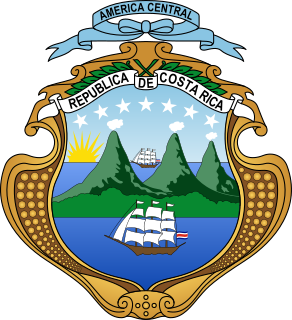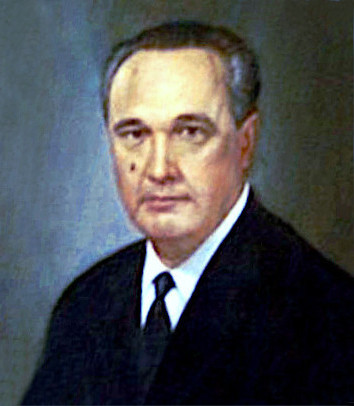
The Legislative Assembly is the unicameral legislative branch of the government of Costa Rica. The national congress building is located in the city capital, San José, specifically in El Carmen District in San José Canton.
The name Constitutional was used for several loosely connected Costa Rican parties throughout history.

Mid-term parliamentary elections were held in Costa Rica on 5 December 1915. The result was a victory for the Republican Party, which received almost two-thirds of the vote. Voter turnout was 50.2%.

Mid-term parliamentary elections were held in Costa Rica on 2 December 1921. The Agricultural Party received the most votes, but only won 25.5% of the total. Voter turnout was 30.4%.

Mid-term parliamentary elections were held in Costa Rica on 6 December 1925. The Republican Party received the most votes. Voter turnout was 35.8%.

General elections were held in Costa Rica on 1 April 1917. Federico Tinoco Granados had seized power in a military coup in January and was the only candidate in the presidential election. The elections were considered to be fraudulent and although former president Rafael Yglesias Castro received 249 votes in Alajuela, they were recorded as invalid ballots. Voter turnout was reported to be 69.2% in the presidential election and 67.6% in the parliamentary election.

Mid-term parliamentary elections were held in Costa Rica on 9 February 1930. The result was a victory for the National Union, which received 32.5% of the vote. Voter turnout was 30.7%.

Mid-term parliamentary elections were held in Costa Rica on 11 February 1934. The result was a victory for the Independent National Republican Party, which received 48.1% of the vote. Voter turnout was 41.6%.

Mid-term parliamentary elections were held in Costa Rica on 13 April 1938. The result was a victory for the National Republican Party, which received 62.1% of the vote. Voter turnout was 70.8%.

Mid-term parliamentary elections were held in Costa Rica on 8 February 1942. The result was a victory for the Independent National Republican Party, which received 63.3% of the vote. Voter turnout was 74.0%.

Mid-term parliamentary elections were held in Costa Rica on 10 February 1946. The result was a victory for the Independent National Republican Party, which received 50.5% of the vote. Voter turnout was 64.3%. They were the last mid-term elections in the country's history.

General elections were held in Costa Rica on 9 February 1936. León Cortés Castro of the Independent National Republican Party won the presidential election, whilst the party also won the parliamentary election, in which they received 59.4% of the vote. Voter turnout was 68.8% in the presidential election and 68.9% in the parliamentary election.

General elections were held in Costa Rica on 11 February 1940. Rafael Ángel Calderón Guardia of the Independent National Republican Party won the presidential election. Voter turnout was 80.8% in the presidential election and 65.6% in the parliamentary election.

General elections were held in Costa Rica on 4 October 1949. They followed the introduction of a new constitution after the Costa Rican Civil War. Voters elected a Vice-President (as none had been chosen in the 1948 elections and the Legislative Assembly. The result was a victory for the National Unity Party, which won 71.7% of the vote. Voter turnout was 43.8% in the vice-presidential election and 49.2% in the parliamentary election.

General elections were held in Costa Rica on 2 February 1958. Mario Echandi Jiménez of the National Union Party won the presidential election, whilst the National Liberation Party won the parliamentary election. Voter turnout was 64.7%.

General elections were held in Costa Rica on 6 February 1966. José Joaquín Trejos Fernández of the National Unification Party won the presidential election, whilst the National Liberation Party won the parliamentary election. Voter turnout was 81.4%.

General elections were held in Costa Rica on 1 February 1970. José Figueres Ferrer of the National Liberation Party won the presidential election, whilst his party also won the parliamentary election. Voter turnout was 83.3%.

General elections were held in Costa Rica on 3 February 2002. For the first time in the country's history, no candidate in the presidential election passed the 40% threshold. This meant a second round of voting had to be held on 7 April which saw Abel Pacheco of the Social Christian Unity Party defeat the National Liberation Party's Rolando Araya Monge.

Constitutional Assembly elections were held in Venezuela on 27 October 1946, following a coup the year before which launched El Trienio Adeco. The result was a victory for Democratic Action, which won 137 of the 160 seats in the Assembly. Voter turnout was 86.6%.

Constitutional Assembly elections were held in Uruguay on 25 June 1933. They followed a presidential coup by Gabriel Terra on 31 March, Following the coup, the Assembly was appointed to formulate a new constitution. The various factions of the Colorado Party emerged as the largest group in the Assembly, winning 151 of the 284 seats.









